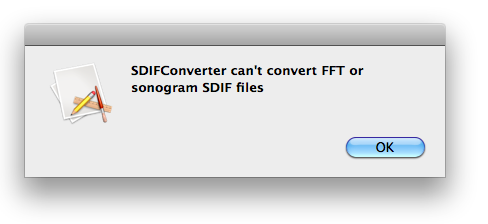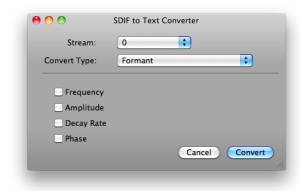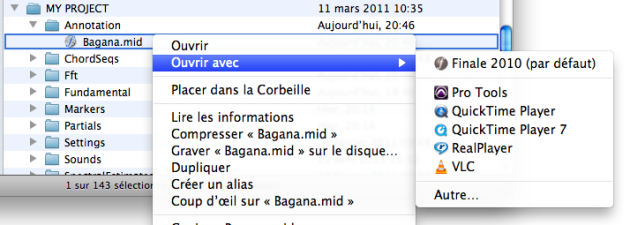- Zoom
Using Files
The idea behind generating and keeping an analysis, a treatment as a persistent file, is to be able to use it again in AudioSculpt, or with other applications. Files can be open in AS directly from their location, with a drag and drop or a Ctrl click, or via the AudioSculpt interface.
Using Persistent Files with AudioSculpt
The Open... menu
In the case of treatment or analysis file, AS looks for the sound file it was associated with automatically.
If the file is found, it will be open in any case, even if another file is already open.
If not, the user is asked to specify a file, and the treatment or analysis file opens in the same AS window.
All analysis or treatment files can be open as such in AudioSculpt from the interface via the Open Analysis/Treatment menu
The Open Treatments... / Open Analysis... only applies to .sdif or .trt files.
If the original sound file of the treatment or analysis is open, the file is loaded automatically.
If no sound file is open, AS opens the original sound file of the treatment or analysis.
If another sound file is open, the user is asked to specify if the file has to be applied to the current file, or to the original file.
A treatment or analysis file can hence be applied to any file. An analysis can be viewed with a different sound file than the one it was calculated from.
Treatments can be open without the sonogram they were possibly associated with.
Files can also be open with a drag and drop on the AS icon, or with a Ctrl + click on the file and choosing AudioSculpt. In this case, AudioSculpt will behave exactly as with the Open... menu.
Specific Use of Sdif Files
The SDIF Converter application allows to extract data from a variety of SDIF files, and convert it into text files. To open the .sdif file with SDIF Converter, just double clik on it. If the file can be converted, an interface will open. |
In some cases, as with sonograms, SDIF Converter cannot find any data to convert and opens a dialogue window.

Other analysis tools, like Diphone Studio, already allow opening and exporting analysis in SDIF format.
SDIF files can also be used in OpenMusic as an abstract support to create new objects for musical composition, by applications like OpenMusic. All or some of the data of the SDIF file can then be integrated in the composition environment as musical material, manipulated with a graphic editor, SDIF-Edit, and a number of OpenMusic tools.
These can also be used for real time processing in Max/Msp via tool like Mubu or Ftm.
Specific Use of MIDI Files
- Using Files


